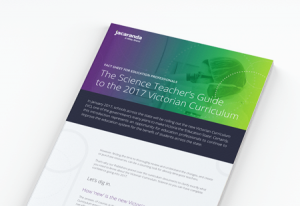This article has been provided courtesy of Jacaranda.
In September 2015, the Victorian Government announced the new Victorian Curriculum as a key pillar of its plan to become the ‘Education State’.
As many teachers will know, change in curriculum is not new in Victoria, and the state has long been at the forefront of innovation in curriculum development. A quick snapshot of the past two decades alone reveals a commitment to ongoing reform and to improving learning outcomes for students.
Here’s a summary of the major innovations:
1995: The Curriculum and Standards Framework (CSF) was first implemented in Victorian schools.
2000: The CFS was republished as the CSF II. The CSF described explicitly what Victorian students should know from years prep through to Year 10 in eight key learning areas.
2006: The CSF II was replaced by the Victorian Essential Learning Standards (VELS) which was built on the strong foundations of the CSF but also emphasised the interdisciplinary skills students needed to succeed in the world; skills such as how to relate to each other, how to understand the world and how to communicate ideas.
2013: The Australian Curriculum in Victoria (AusVELS) was implemented.
2015: The Victorian Government introduced the new Victorian Curriculum, which can be implemented from 2016 and must be implemented by 2017. The curriculum ‘is the common set of knowledge and skills required by students for life-long learning, social development and active and informed citizenship.’1
As with any curriculum change, there are differences will need to be factored in. While teachers in Victorian schools have proven themselves highly adept at incorporating practical and aspirational elements of each curriculum reform phase, managing the transition can be an overwhelming task. In particular, the 2017 Victorian Curriculum not only introduces several changes that apply across all learning areas, but a number of subject-specific changes as well.

The overall impact, therefore, will inevitably vary by subject. To find out what the 2017 Victorian Curriculum means for you, download Jacaranda’s fact sheet. There’s one for each learning area: Mathematics, Science, Humanities, English and Health and Physical Education. This definitive guide will provide:
- Summary of the key changes that all teachers must implement
- Description of the General Capabilities
- Outline of structural and content changes for each learning area
- Insights from our publishing team
We hope the fact sheet is a useful resource to help teachers gain confidence going into 2017. If you have any additional questions about what the curriculum changes mean for you, don’t hesitate to email us.
Reference
1. Source: http://victoriancurriculum.vcaa.vic.edu.au/



